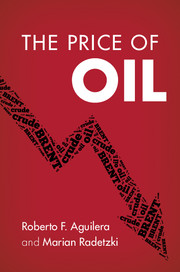Book contents
- Frontmatter
- Contents
- Figures
- Tables
- Acknowledgments
- 1 Introduction and overview
- PART I OIL'S EXTRAORDINARY PRICE HISTORY: HOW CAN IT BE EXPLAINED?
- 2 The price of oil since the early 1970s: observations and implications
- 3 OPEC and its behavior cannot explain oil's price performance
- 4 Can depletion and rising costs explain the price developments?
- 5 State ownership, government greed and the slowdown of capacity expansion
- 6 The resource curse and capacity destruction
- PART II THE SHALE AND CONVENTIONAL OIL REVOLUTIONS: LOW PRICES AHEAD
- PART III GLOBAL IMPLICATIONS FOR THE MACROECONOMY, THE ENVIRONMENT AND FOR POLITICS
- CONCLUSIONS
- References
- Index
2 - The price of oil since the early 1970s: observations and implications
from PART I - OIL'S EXTRAORDINARY PRICE HISTORY: HOW CAN IT BE EXPLAINED?
Published online by Cambridge University Press: 05 November 2015
- Frontmatter
- Contents
- Figures
- Tables
- Acknowledgments
- 1 Introduction and overview
- PART I OIL'S EXTRAORDINARY PRICE HISTORY: HOW CAN IT BE EXPLAINED?
- 2 The price of oil since the early 1970s: observations and implications
- 3 OPEC and its behavior cannot explain oil's price performance
- 4 Can depletion and rising costs explain the price developments?
- 5 State ownership, government greed and the slowdown of capacity expansion
- 6 The resource curse and capacity destruction
- PART II THE SHALE AND CONVENTIONAL OIL REVOLUTIONS: LOW PRICES AHEAD
- PART III GLOBAL IMPLICATIONS FOR THE MACROECONOMY, THE ENVIRONMENT AND FOR POLITICS
- CONCLUSIONS
- References
- Index
Summary
Part I of our book has a principal objective: to provide explanations for the spectacular oil price increases of the past 40 years. The first section of this chapter, however, is an eye-opening detour that describes oil's price behavior since 1970 and its contrasting experience with a broad metals group over the same period. A brief history is then given of famous events that had impacts on oil prices, followed by the evolving pricing conventions over the decades. We then touch on market speculation and rapid consumption growth – frequently blamed for high oil prices – but mostly dismiss their roles in driving prices up. We close the chapter by assessing the grand importance of oil in the world economy.
A COMPARATIVE PERSPECTIVE
To give a perspective to the oil price performance since the beginning of the 1970s, Figure 2.1 compares an index of oil prices with an index of metal and mineral prices, all in real terms. The comparison yields striking results. The price of oil has recorded an astounding increase of 886 percent from 1970–1972 to 2011–2013, while the metals and minerals index has risen by a mere 68 percent. One might object to the comparison, claiming that a broad metals and minerals index could easily hide exceptional price cases for individual products. We have therefore investigated the price histories for four individual metals and minerals materials, to find a rise from 1970–1972 to 2011–2013 at 133 percent for iron ore, 67 percent for copper, 50 percent for nickel, and a decline of 16 percent for aluminum. Oil continues to be exceptional in this comparison.
The short-run instability for metals and minerals in aggregate does not emerge well in the graphical presentation of Figure 2.1. However, the United Nations Conference on Trade and Development (UNCTAD) produces price instability indexes for commodities, which permit us to compare this aspect of pricing between oil and the metals. UNCTAD's numbers demonstrate a somewhat higher instability value for oil compared to the aggregate of minerals and metals during the decades of 1983–1992 and 1993–2002, but a lower one for 2003–2012.
- Type
- Chapter
- Information
- The Price of Oil , pp. 11 - 22Publisher: Cambridge University PressPrint publication year: 2015



